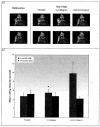New Insights Into Old Puzzles From Infants' Categorical Discrimination of Soundless Phonetic Units
- PMID: 19823599
- PMCID: PMC2759762
- DOI: 10.1207/s15473341lld0203_1
New Insights Into Old Puzzles From Infants' Categorical Discrimination of Soundless Phonetic Units
Abstract
For 4 decades, serious scientific debate has persisted as to whether infants' remarkable capacity to detect and categorize phonetic units is derived from language-specific mechanisms or whether this capacity develops out of general perceptual mechanisms. The heart of this controversy has revolved around whether the young human brain is specialized to detect the underlying contrasting patterns in language or whether it simply processes general auditory perceptual features of sound that, over time, become utilized for language learning. This article takes a novel look at this question by using soundless phonetic units from a natural signed language as a new research tool. Research finds that 4-month-old hearing infants categorize soundless phonetic units on the basis of linguistic category membership, whereas 14-month-old infants fail to do so-thereby exhibiting the identical initial capacity and classic developmental shift in infant categorical discrimination of native and nonnative (foreign language) phonetic units in speech. These results suggest a novel testable hypothesis: Infants may begin life with the capacity to detect specific patterned units with alternating contrasts unique to natural language organization and to categorize them on the basis of linguistic category membership.
Figures

References
-
- Abramson AS. Identification and discrimination for phonemic tones. Journal of the Acoustical Society of America. 1961;33:842.
-
- Aslin RN. Visual and auditory development in infancy. In: Osofsky JD, editor. Handbook of infant development. 2. Oxford, England: Wiley; 1987. pp. 5–97.
-
- Atkinson J. The developing visual brain. Cambridge, England: Oxford University Press; 2000.
-
- Battison R. Lexical borrowing in American sign language. Silver Spring, MD: Linstock; 1978.
Grants and funding
LinkOut - more resources
Full Text Sources
